Mineral Chemistry Studies and Evidences For Magma Mixing of Bala Zard Basic- Intermediate Volcanic Rocks, Lut Block, Iran
Omid Kheiri Namin1 * , Afshin Ashja Ardalan1 , Mohammad Hosein Razavi2 , Arash Gourabjeripour3 and Abdollah Yazdi4
1
Department of Geology, Faculty of Sciences,
Islamic Azad University,North Tehran Branch,
Tehran,
Iran
2
Department of Geology, Faculty of Sciences,
Kharazmi University,
Tehran,
Iran
3
Department of Geology,
Islamic Azad University, Mianeh Branch,
East Azerbaijan,
Iran
4
Department of Geology,
Islamic Azad University, Kahnooj Branch,
Kerman,
Iran
Corresponding author Email: o.Kheiri@gmail.com
DOI: http://dx.doi.org/10.12944/CWE.10.Special-Issue1.140
Bala Zard volcanic rocks are erupted in the Lut Block in Eastern Iran and exposed about 270 Km north east of Kerman city. The volcanic rocks mainly consist of basalt, andesite, dacite, and rhyodacite. Petrographic studies show that several disequilibrium textures such as sieve texture and oscillatory zoning in plagioclase phenocrysts are present in some of the minerals of BalaZard volcanic rocks. Mineral chemistry studies revealed compositional changes along with the textural changes in minerals from the study area. The observed oscillatory zoning profile for the anorthite content (An) of plagioclase suggests repeated injections of mafic melts (replenishment) and mixing with pre-exiting magma and forming rocks with basaltic-andesite composition. The chemical composition of clinopyroxene phenocrysts exhibit calc-alkaline affinity and suggest that Bala Zard volcanic rocks formed in a subduction related volcanic arc.
Copy the following to cite this article:
Namin O. K, Ardalan A. A, Razavi M. H, Gourabjeripour A, Yazdi A. Mineral Chemistry Studies and Evidences For Magma Mixing of Bala Zard Basic- Intermediate Volcanic Rocks, Lut Block, Iran. Special Issue of Curr World Environ 2015;10(Special Issue May 2015). DOI:http://dx.doi.org/10.12944/CWE.10.Special-Issue1.140
Copy the following to cite this URL:
Namin O. K, Ardalan A. A, Razavi M. H, Gourabjeripour A, Yazdi A. Mineral Chemistry Studies and Evidences For Magma Mixing of Bala Zard Basic- Intermediate Volcanic Rocks, Lut Block, Iran. Special Issue of Curr World Environ 2015;10(Special Issue May 2015). Available from: http://www.cwejournal.org?p=791/
Download article (pdf)
Citation Manager
Publish History
Select type of program for download
| Endnote EndNote format (Mac & Win) | |
| Reference Manager Ris format (Win only) | |
| Procite Ris format (Win only) | |
| Medlars Format | |
| RefWorks Format RefWorks format (Mac & Win) | |
| BibTex Format BibTex format (Mac & Win) |
Article Publishing History
| Received: | 2014-11-10 |
|---|---|
| Accepted: | 2015-12-30 |
Introduction
Magmatic activities in Iran reached its climax in the Cenozoic era, resulted in widespread volcanic and pyroclastic eruptions all over the country, particularly in the Urumia-Dokhtar magmatic arc and Lut Block volcanic belt in the east of Iran (Fig. 1 A & B).Bala Zard area is located in the Lut desert in Eastern Iran and exposed about 270 Km north east of Kerman city. The study area is situated within longitudes 58°, 43', 00'' to 59°, 03', 00'' and latitudes 31°, 00', 00'' to 31°, 15', 00'' and covers an area of 810 square kilometers (Fig. 2).In this paper we study the magma mixing features of the Bala Zard basic and intermediate volcanic rocks. We present new data on the geochemistry and mineral chemistry of the volcanic rocks and their minerals to better determine their chemical compositions and tectonic setting. Magma mixing is an inevitable process during a volcanic arc build up and its evolution. It usually occurs by repeated injections of new and hotter mafic magma chambers (replenishment) and mixing with pre-existing magma in which is crystallizing continuously in a cooling magma chamber (Feeley and Dungan., 1996 ; Geshi, 2000). Magma mixing in the subduction related calc-alkaline rocks has been studied by many researchers (e.g. Gerlach and Grove, 1982 ; best, 2001).
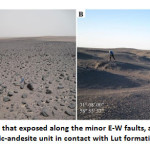 |
Figure 1: Basaltic unit that exposed along the minor E-W faults, and dacitic domein the left (A), basaltic-andesite unit in contact with Lut formation (looking south). Click here to View figure |
Geological setting
The Bala Zard area is mainly consists of Cenozoic volcanic series which are widespread in the Lut Block and are known as Lut volcanics. In the area volcanic activities commenced by subaerial basalt and basaltic-andesite eruptions followed by rhyodacite and rhyolite lavas and tuffs, and finally extensive red and gray andesitic lavas and tuffs erupted all over the area (Camp and Griffis, 1982). The Jurassic-Cretaceous sedimentary and metamorphic rock units are regionally covered by volcanic rocks in the Lut block (Fig. 2), however, in the Bala Zard area these older units are not exposed except near Koh Sorkh in the northern part of the study area.
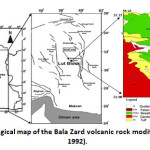 |
Figure 2: Simplified geological map of the Bala Zard volcanic rock modified after (Hoseini et al., 1992). Click here to View figure |
Material and Methods
A field trip was conducted and a suite of 200 samples were collected representing different lithologies in the area, and 160 samples from the least altered or deformed rocks were selected for petrographic studies. After petrographic studies a suite of 16 samples from the basic and intermediate rocks were selected for X-Ray Probe Micro Analyser (XPMA). In the present study the electron probe microanalysis has been made to determine the chemical compositions of plagioclase, pyroxene, and glassy mesostasis both in the groundmass and inside the sieved plagioclases. Quantitative mineral and glass analyses were carried out using XPMA, XGT-7200 Horiba model at the Kansaran Binaloud labopratori in Iran, performed with accelerating voltage of 50kv at 1mA and a beam diameter of 10 micron and ran for 80 seconds. Then mineral and glass chemical compositions results are plotted using different diagrams to determine their tectonic setting, alkalinity, mineral types, and geochemical changes along the line-scan profiles from core to rim of minerals.
Discussion
Petrography
Detailed petrographical and textural studies of the Bala Zard samples show that volcanic rocks are mostly porphyritic, and mainly consist of basalt, andesitic-basalt, and trachyandesite. The dominant minerals are plagioclase phenocrysts, clinopyroxene, and amphibole ± olivine. The volcanic rocks contain between 10 to 40 percent of phenocrysts that are set in glassy and micro-crystalline groundmass consisting of fine-grained plagioclase, pyroxene, and opaque minerals (Fig. 3 & 4). The accessory minerals such as apatite and zircon can be seen in some of the volcanic rocks. Other than porphyritic texture (the main texture in the samples), other textures are present such as vitrophyric, hyalo-microlitic porphyritic, hyalo-microcrystalline, and finally amygdaloidal texture in which vesicles have been filled in with secondary minerals such as chalcedony, chlorite, and zeolite. Textures like glomeroporphyritic, intergranular, sub-ophitic, poikilitic, sieve and the others shch as normal and oscillatory zoning are also present in the volcanic rocks. Several disequilibrium textures are present in Bala Zard volcanic rocks suggesting magma mixing occurred during magmatic activities in the study area. These disequilibrium textures include sieve textures, oscillatory zoning, glomeroporphyritic, reaction rims, embayed or corroded mineral which are discussed below.
Sieve texture
Sieve texture is one of the disequilibrium textures in magmatic rocks that occurs during crystallization of magmas. This texture presents in basaltic-andesite, andesite and trachyandesitic rocks in the study area (Fig. 3 A, C, D, E), and may reflect rapid decompression of magma chambers (Kuscu and Floyd, 2001). However, sieve texture might forms by injections of mafic melts (replenishment) and mixing with pre-exiting magma (Stimac and Pearce, 1992 ;Kuscu and Floyd, 2001 ; Izbecov et al., 2002 ; Reubi et al., 2002 ; Karsli et al., 2004 ; Price et al., 2005).The concurrent presence of sieved and normal plagioclases in a sample and also sieved plagioclases that are surrounded by oscillatory plagioclase indicate the role of magma mixing during their formation. The chemical composition of three sieved plagioclase and their trapped glassy materials were analyzed using XPMA method and results show the glassy materials have a calcium content similar to the average plagioclase calcium content.
Oscillatory zoning
Oscillatory zoning in plagioclase occurs mostly in the Bala Zard andesitic and basaltic andesite rocks (Fig. 3 B, C, D). Oscillatory zoning in minerals represents disequilibrium in a magmatic system, and expresses a specific condition of P, T, X during crystallization. Magma replenishment by new magma batches and their interaction with pre-exiting magma, in a dynamic and convective magma reservoir changes the thermodynamic conditions of the magma chamber continuously, hence melt-crystal ion-exchange during crystallization of magmas seldom achieves equilibrium (Holten et al., 1997; Holten et al., 2000). The ion-exchange of Al, Si and Na between liquid and plagioclase during crystallization is kinetically very slow, therefore plagioclase composition is controlled primarily by the amount of H2O in the melt, the magma ascent rate, and residence time in the magma chamber. The dominant zoning in the plagioclase phenocrysts of Bala Zard volcanics is oscillatory zoning, thus magma replenishment by new magma batches and their interaction with pre-exiting magma, in a dynamic and convective magma reservoir might formed the oscillatory plagioclase phenocrysts (Gioncada et al., 2005; Singer et al., 1993; Shelley, 1993).
Glomeroporphyritic texture
Glomeroporphyritic texture mainly occurs in the Bala Zard basaltic samples (Fig. 3F). Sudden injections of new magma batches (replenishment) into a crystallizing magma is one of the most important reasons that may forms glomeroporphyritic texture via mixing different melts. However, concurrent decreasing density and increasing viscosity of residual melt could result in aggregation of dense phenocrysts as mineral clots at the bottom of magma chambers (Zhu et al., 2009).
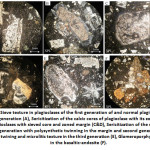 |
Figure 3: Sieve texture in plagioclases of the first generation of and normal plagioclases of second generation (A), Sericitization of the calcic cores of plagioclase with its zoned margin (B), plagioclases with sieved core and zoned margin (C&D), Sericitization of the sieved cores of first generation with polysynthetic twinning in the margin and second generation with traverse twining and microlitic texture in the third generation (E), Glomeroporphyritic texture in the basaltic-andesite (F). Click here to View figure |
Presence of blobs with different composition in the intermediate magmas
During injection of new mafic magma batches into an evolved magma chamber with relatively intermediate-acidic composition,and due to immiscibility some blobs of the mafic melts may remain inside the acidic magmas (Fig 4 C & D).
Interaction of two magmas with different composition
In the Bala Zard area there are volcanic rocks with two different magmas with sharp contrasting colors (Fig. 4 E&F). We performed XMPA analyses for the groundmass and plagioclase phenocrysts of the both rock types, and results show that the mafic part is compositionally more basic compared to the felsic part.
Sieve texture, embayment and rounding in pyroxene phenocrysts (corroded and rounded pyroxene)
Some of pyroxene phenocrysts in Bala Zard volcanic are sieved, corroded, and rounded (Fig. 4 A & B). These textures also represent disequilibrium in magmas. In general, concurrent presence of normal and sieved pyroxene phenocrysts in the study area samples represent magma mixing (Lofgern, 1980). However, these textures might develop during rapid compositional changes in the magma chambers. For example,when the magma temperature increases rapidly by repeated injections of new and hotter magma batches, it may lead to corrosion of pre-existing minerals such as pyroxene and amphibolein the magma chamber (Tamura and Tatsumi, 2002). Any interactions with the new and hotter magma batches would consequently make the pyroxene phenocrysts embayed and rounded(Shelly, 1993; Gill, 2010).
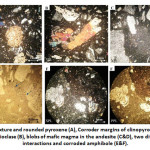 |
Figure 4: Sieve texture and rounded pyroxene (A), Corroder margins of clinopyroxene and sieve texture in plagioclase (B), blobs of mafic magma in the andesite (C&D), two different magma interactions and corroded amphibole (E&F). Click here to View figure |
Mineral Chemistry
Plagioclase and pyroxene phenocrysts are the main constituents of the Bala Zard volcanic rocks, and hold information on the chemical evolution of magmas. The XPMA data are summarized in tables 1 and 2:
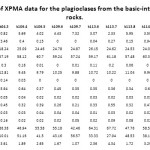 |
Table1: Summary of XPMA data for the plagioclases from the basic-intermediate volcanic rocks. Click here to View table |
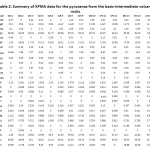 |
Table2: Summary of XPMA data for the pyroxenes from the basic-intermediate volcanic rocks. Click here to View table |
Plagioclase
Basalt
According to XPMA data the range of anorthite content (An) of plagioclase phenocrysts of basaltic samples varies between An52 and An92 (Fig. 5 A), and these plagioclases mostly plot in the field of anorthite to labradorite in Ab-An-Or diagram (Deer et al., 1992). This problem could be explained by presence of two plagioclase generations in the basaltic rocks in the study area.
Basaltic andesite
The anorthite content in the plagioclase phenocrysts from the basaltic andesites is continues (An53-An90) and samples plot in the field of bytownite to labradorite (Fig. 5 B). The zoned plagioclases mostly occur in this rock type in the study area.
Andesite and Trachyandesite
The range of anorthite content of plagioclase in this rock type is continuous between labradorite and andesine (An39-An67). However, most of the plagioclases in these rocks are Ca-rich (labradorite). In the samples with trachy andesitic composition, anorthite content varies between bytownite and andesine (An43-An75). Although the anorthite content in these rocks shows a bimodal distribution, suggesting two phases of magma differentiation in the study area (Fig. 5 C).
The anorthite content of plagioclase phenocrysts of the Bala Zard volcanic rocks is relatively higher than the whole rock composition. In general, Plagioclase composition is controlled primarily by the amount of H2O in the melt. It is therefore believed that higher anorthite content is related to the higher H2O content in the magma source and this suggests a subduction related magmatic arc setting for the volcanic rocks (Gill, 2010).
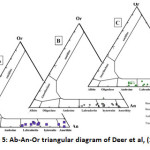 |
Figure 5: Ab-An-Or triangular diagram of Deer et al, (1992) Click here to View figure |
Zoning in plagioclase
In Bala Zard volcanic rocks oscillatory plagioclase occurs mostly in basaltic-andesite and andesitic samples. In this study, core to rim in-situ analyses were performed using XPMA to determine the chemical variations and zoning in the plagioclase phenocrysts. The anorthite content of a zoned plagioclase in andesite varies between An39 and An43, which define an andesine composition (Fig. 6A). Some investigations have shown that anorthite content generally decreases with magma chamber decompression during major volcanic explosion and increases again with increasing pressure of the magma chamber (Blundy et al., 2008). In Bala Zard basaltic-andesites the anorthite content changes suddenly. In these plagioclase phenocrysts a normal zoning is observed at first in the mineral’s core with an andesine composition and then anorthite content suddenly increases to An88, and then the An values of plagioclase fluctuate with maximum compositional variation of 33%. This define an oscillatory zoning in the basaltic-andesites, suggesting that magma mixing occurred during injection of hot and Ca-rich mafic magmas into the magma chamber. The anorthite content shows the greatest variation in the reverse zoning plagioclase phenocrysts, which is considered as an indication for the noticeable temperature differences between the two mixing magmas (Gerebe and Thouret, 2004).
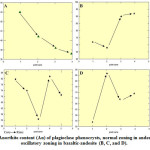 |
Figure 6: Anorthite content (An) of plagioclase phenocrysts, normal zoning in andesite (A), oscillatory zoning in basaltic-andesite (B, C, and D). Click here to View figure |
Pyroxene
Clinopyroxene is one of the main rock forming minerals in the Bala Zard volcanic rocks. Morimoto and coworkers (1988) have classified pyroxenes into four group based on cations substitutions in the M1 and M2 occupation sites. All of the Bala Zard pyroxenes plot in the Quad except one which is plotted in the Na-Ca field. Pyroxenes plot in the Quad (Fig. 7 A), hence we plot the results on the Wo-En-Fs triangular diagram which is widely used for chemical classification of pyroxenes. Pyroxenes from the volcanic rocks mostly plot in the field of diopside-augite. However one of the samples plotted in the pigeonite filed. Pyroxene in the basaltic rocks is more Ca-enriched compared to the intermediate andesitic rocks (Fig. 7 B).
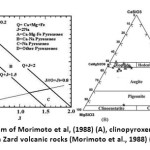 |
Figure 7: Q versus J diagram of Morimoto et al, (1988) (A), clinopyroxene classification of the Bala Zard volcanic rocks (Morimoto et al., 1988) (B). Click here to View figure |
The minor element contents of pyroxene phenocrysts such as Ti, Al, Na, Cr and particularly their Si content are an indicator for understanding the host rocks geochemical evolution and tectonic setting. Clinopyroxene is therefore used for defining the magmatic series and also the geodynamic settings of magmas (Le Bas, 1962; Leterrier et al., 1982). In this regards, the chemical composition of Bala Zard pyroxenes are enriched in Si and plot in the field of sub-alkaline rocks (Fig. 8 A). Le Bas, (1962) believes that the substitution of Al, Si, and Ti into the pyroxene crystal lattice is highly dependent on the alkalinity of magmas and therefore the pyroxenes of the study area are depleted in Ti content and plot in the field of calc-alkaline suites (Fig. 8 B).
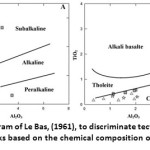 |
Figure 8: Bivariate diagram of Le Bas, (1961), to discriminate tectonic setting of ala Zard volcanic rocks based on the chemical composition of clinopyroxene. Click here to View figure |
In order to define the tectonic setting of Bala Zard volcanic rocks, we have also used bivariate diagrams. One of these diagrams is based on the Ti versus Ca+Na (Leterrier et al., 1982), in which most of samples plot in the fields of tholeiitic and calc-alkaline basalts (Fig. 9A). On a Ti versus Al diagram (Fig 9 C), samples mostly show calc-alkaline affinity. On a Ti versus Ca (Fig. 9 B), clinopyroxenes from the study area plot in the island arc basalts.
There are other diagrams to discriminate clinopyroxene compositions in order to define their tectonic setting such as F1 versus F2 diagram of Nisbet and Pearce, (1977). The study area clinopyroxenes define a volcanic arc tectonic setting for the rock samples from the Bala Zard vocanic rocks (Fig. 9 D). F1 and F2 components are shown below :
F1 = - (0.012 x SiO2) - (0.0807 x TiO2) + (0.0026 x Al2O3) - (0.0012 x FeO*) - (0.0026 x
MnO) + (0.0087 x MgO) - (0.0128 x CaO) - (0.0419 x Na2O)
F2 = - (0.0469 x SiO2) - (0.0818 x TiO2) - (0.0212 x Al2O3) - (0.0041 x FeO*) - (0.1435 x
MnO) - (0.0029 x MgO) + (0.0085 x CaO) + (0.016 x Na2O)
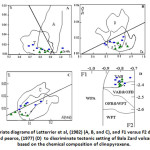 |
Figure 9: Bivariate diagrams of Letterrier et al, (1982) (A, B, and C), and F1 versus F2 diagram of Nisbet and pearce, (1977) (D) to discriminate tectonic setting of Bala Zard volcanic rocks based on the chemical composition of clinopyroxene. Click here to View figure |
Conclusions
- The presence of oscillatory zoning (with a range of An content of 33%), occurrence of sieve texture in the first plagioclase generation in the basaltic-andesites and other evidences for magma mixing, our study suggests that these rocks were formed by injection of new mafic and hotter magma batches into a pre-exiting magma chamber and basic-intermediate magma mixing.
- The chemical compositions of plagioclases in basaltic rocks plot in the field of anorthite to labradorite, basaltic-andesite between bytownite and labradorite, andesite in the field of labradorite to andesine, and for trachyandesite in the field of bytownite and andesine.
- The clinopyroxene composition of basalts, basaltic-andesites, and andesites are mostly diopside and augite, however, pyroxenes in the basaltic rocks are more ca-rich compared to the rest of rock types in the study area.
- Our mineral chemistry and XPMA results show that the Bala Zard volcanic rocks are calc-alkaline in nature and formed in a subduction zone setting.
References
- Feeley, T.C. & Dungan, M.A., 1996. Compositional and dynamic controls on mafic–silicic magma interactions at continental arc volcanoes: evidence from Cordon El Guadal, Tatara-San Pedro Complex. Chile. Journal of Petrology 37, 1547–1577.
- Geshi, N., 2000. Fraction and magma mixing within intruding dike swarm: evidence from the Miocene Shitara-Otoge igneous complex, central Japan. Journal of Volcanology and Geothermal Research 98, 127–152.
- Gerlach, D. C., and Grove, T. L., 1982. Petrology of medicine lake Highland volcanic: characterization of end-members of magma mixing. Ibid. 80, 147-59.
- Best, M. G. & Christiansen, E. H. 2001. Igneous Petrology. xvi+458 pp. Oxford: Blackwell Science.
- Camp, V., and Griffis, R., 1982, Character, genesis and tectonic setting of igneous rocks in the Sistan suture zone, eastern Iran. Lithous, Issn 0024-4937, v. 15, 3, pp. 221-239.
- Hoseini, Z. & Chaichi, Z. 1992: Geological map of Deh Salm (Chah Vak) 1:250000 survey sheet. Geological Survey of Iran. Tehran.
- Kuscu G., Floyd, P. A., 2001, Mineral compositional and textural evidence for magma mingling in the Saraykent volcanics. Lithos 56, p, 207–230.
- Stimac, J.A., Pearce, T.H., 1992. Textural evidence of mafic–felsic magma interaction in dacite lavas, Clear Lake, California. American Mineralogist, 77, pp. 795– 809.
- Izbekov, P.E., Eichelberger, J.C., Patino, L.C., Vogel, T.A., Ivanov, B.V., 2002. Calcic cores of plagioclase phenocrysts in andesite from Karymsky Volcano: evidence for rapid introduction by basaltic replenishment. Geology 30, 799– 802.
- Reubi , Nicholls, I.A., Kamenetsky, V.S., 2002, Early mixing and mingling in the evolution of basaltic magmas: evidence from phenocryst assemblages, Slamet Volcano, java, Indonesia. Journal of Volcanology and Geothermal Research, 119, p, 255-274.
- Karsli, , Aydin, F., Sadiklar, M. B., 2004, Magma Interaction Recorded in plagioclase Zoning in Granitoid Systems, Zigana Granitoid, Eastern Pontides, Turkey Turkish Journal of Earth Sciences, Vol. 13, pp. 287-305.
- Price, C., Gamble, J. A., Smith, I. E.M., Stewart, R. B., Eggins, S., Wright, I. C., 2005, An integrated model for the temporal evolution of andesites and rhyolites and crustal development in New Zealand’s North Island Journal of Volcanology and Geothermal Research, 140, 1-24
- Holten, T., Jamtvit, B., Meakin, P., Cortini, M., Blundy, J., Austerheim, H., 1997, Statistical characteristics and origin of oscillatory zoning in crystals. American Mineralogist, Volume 82, pages 596-606.
- Holten, , Jamtveit, B., Meakin, P., 2000, Noise and oscillatory zoning of minerals. Geochimica et Cosmochimica Acta, Vol. 64, No. 11, pp. 1893–1904
- Gioncada, , Mazzuoli, R., Milton, A.J., 2005, Magma mixing at Lipari (Aeolian Islands, Italy): Insights from textural and compositional features of phenocrysts. Journal of Volcanology and Geothermal Research, 145, p, 97– 118
- Singer, B. S., Pearce, T. H., Kolisnik, A. M., Myres, J. D., 1993, Plagioclase zoning in mid-Pleistocene lavas from the Seguam volcanic center, central Aleutian arc, Alaska. American Mineralogist, Volume 78, pages 143-157.
- Shelley, D., 1993, Igneous and metamorphic rocks under the microscope. Chapman and Hall, pp. 445
- Zhu, D.C., Zhao, Z.D., Pan, G.T., Lee, H.Y., Kang, Z.Q., Liao, Z.L., Wang, L.Q., Li, G.M., Guo-Chen Dong a, Bo Liu ., (2009). “Early cretaceous subduction-related adakite-like rocks of the Gangdese Belt, southern Tibet: Products of slab melting and subsequent melt–peridotite interaction?”. Journal of Asian Earth Sciences 34, 298–309.
- Lofgren, G. E., 1980. Experimental studies on the dynamic crystallization of silicatemelts. In:Hargraves,R. B. (ed.) Physics ofMagmatic Processes. Princeton, NJ: Princeton University Press, 487–551.
- Tamura, Y. & Tatsumi, Y. (2002). Remelting of an andesitic crust as a possible origin for rhyolitic magma in oceanic arcs: An example from the Izu^Bonin arc. Journal of Petrology43,1029-1047.
- Gill, Robin, 2010. Igneous rocks and processes: a practical guide ., 428.
- Deer, W. A., Howie, R. A. and Zussman, J. (1992) An Introduction to the Rock forming Minerals. London, Longman.
- Blundy, J., Cashman, K. & Berlo, K. (2008). Evolving magma storage conditions beneath Mount St. Helens inferred from chemical varia tions in melt inclusions from the 1980-1986 and current eruptions. In: Sherrod, D. R, Scott, W. E. & Stauffer, P. H. (eds)A volcano rekindled; the renewed eruption of Mount St. Helens, 2004-2006. US Geological Survey Professional Papers1750.
- Gerebe, M.C. & Thouret, J.c., 2004. Role of magma mixing in the petrogenesis of tephra erupted during the 1990-98 explosive activity of Nevada Sabancaya, Southern Peru. Bulletin of Volcanology 66, 541-561
- Morimoto, N., Fabrise, J., Ferguson, A., Ginzburg, I. V., Ross, M., Seifert, F. A., Zussman, J., Aoki, K. and Gottardi, G. (1988) Nomenclature of pyroxene. Mineralogical Magazine 52: 535-555.
- Le Bas M.J., The role of aluminum in igneous. clinopyroxenes with relation to their parentage, American Journal of Science 260, 267-288P, 1962.
- Leterrier, J., Maury, R. C., Thonon, P., Girard, D. and Marchal M. (1982) Clinopyroxene composition as a method of identification of the magmatic affinities of paleo-volcanic series. Earth and Planetary Science Letters 59(1): 139–154
- Nisbet, E. G. and Pearce, J. A. (1977) Clinopyroxene composition in mafic lavas from different tectonicsettings. Contributions to Mineralogy and Petrology 63: 149-160.






